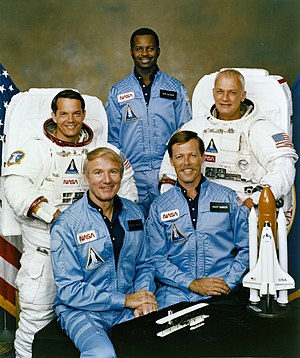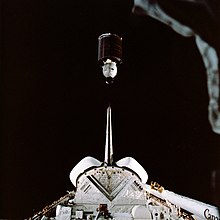


Bruce McCandless II demonstrates the Manned Maneuvering Unit (MMU), floating in space above a clouded Earth.
| |
| Names | Space Transportation System-41B STS-11 |
|---|---|
| Mission type | Communications satellites deployment Equipment testing |
| Operator | NASA |
| COSPAR ID | 1984-011A |
| SATCAT no. | 14681 |
| Mission duration | 7 days, 23 hours, 15 minutes, 55 seconds (achieved) |
| Distance travelled | 5,329,150 km (3,311,380 mi) |
| Orbits completed | 128 |
| Spacecraft properties | |
| Spacecraft | Space Shuttle Challenger |
| Launch mass | 113,603 kg (250,452 lb) |
| Landing mass | 91,280 kg (201,240 lb) |
| Payload mass | 12,815 kg (28,252 lb)[1] |
| Crew | |
| Crew size | 5 |
| Members |
|
| EVAs | 2 |
| EVA duration | 12 hours, 12 minutes First: 5 hours, 55 minutes Second: 6 hours, 17 minutes |
| Start of mission | |
| Launch date | February 3, 1984, 13:00:00 UTC |
| Rocket | Space Shuttle Challenger |
| Launch site | Kennedy Space Center, LC-39A |
| Contractor | Rockwell International |
| End of mission | |
| Landing date | February 11, 1984, 12:15:55 UTC |
| Landing site | Kennedy Space Center, Runway 15 |
| Orbital parameters | |
| Reference system | Geocentric orbit[2] |
| Regime | Low Earth orbit |
| Perigee altitude | 307 km (191 mi) |
| Apogee altitude | 317 km (197 mi) |
| Inclination | 28.50° |
| Period | 90.80 minutes |
| Instruments | |
| Get Away Special (GAS) canisters | |
 STS-41-B mission patch  Standing: Mission Specialists Robert L. Stewart, Ronald McNair and Bruce McCandless II. Stewart and McCandless are wearing Extravehicular Mobility Units (EMUs). Seated: Vance D. Brand and Robert L. Gibson
← STS-9
STS-41-C (11) →
| |
STS-41-B was NASA's tenth Space Shuttle mission and the fourth flight of the Space Shuttle Challenger. It launched on February 3, 1984 and landed on February 11, 1984, after deploying two communications satellites. It was also notable for including the first untethered spacewalk.
Following STS-9, the flight numbering system for the Space Shuttle program was changed. Because the original successor to STS-9, STS-10, was canceled due to payload delays, the next flight, originally and internally designated STS-11,[3][4] became STS-41-B as part of the new numbering system.
| Position | Astronaut | |
|---|---|---|
| Commander | Vance D. Brand Third spaceflight | |
| Pilot | Robert L. Gibson First spaceflight | |
| Mission Specialist 1 | Bruce McCandless II First spaceflight | |
| Mission Specialist 2 | Robert L. Stewart First spaceflight | |
| Mission Specialist 3 | Ronald E. McNair Only spaceflight | |
| Seat[6] | Launch | Landing |  Seats 1–4 are on the Flight Deck. Seats 5–7 are on the Middeck. |
|---|---|---|---|
| S1 | Brand | Brand | |
| S2 | Gibson | Gibson | |
| S3 | McNair | McCandless | |
| S4 | Stewart | Stewart | |
| S5 | McCandless | McNair |




The STS-41-B crew included commander Vance D. Brand, making his second Shuttle flight; pilot Robert L. Gibson; and mission specialists Bruce McCandless II, Ronald E. McNair, and Robert L. Stewart.
Challenger lifted off from Kennedy Space Center at 08:00:00 a.m. EST on February 3, 1984. It was estimated that 100,000 people attended the launch.[7] Two communications satellites were deployed about 8 hours after launch; one, Westar 6, was for America's Western Union, and the other, Palapa B2, for Indonesia;[8] both were Hughes-built HS-376-series satellites. However, the Payload Assist Modules (PAM) for both satellites malfunctioned, placing them into a lower-than-planned orbit. Both satellites were retrieved successfully in November 1984 during STS-51-A, which was conducted by the orbiter Discovery.[8]
On February 7, the fourth day of the mission, astronauts McCandless and Stewart performed the first untethered spacewalk, operating the Manned Maneuvering Unit (MMU) for the first time.[5][9] At 8:25 a.m. EST, pulsing the MMU's thrusters, McCandless ventured out of Challenger's payload bay, and reached 98 m (322 ft) from the orbiter.[10] Stewart tested the "work station" foot restraint at the end of the Remote Manipulator System (Canadarm).[10] On the seventh day of the mission, both astronauts performed another extravehicular activity (EVA) to practice capture procedures for the Solar Maximum Mission (SMM) satellite retrieval and repair operation, which was planned for the next mission, STS-41-C.[5]
STS-41-B also achieved the reflight of the West German-sponsored SPAS-1 pallet/satellite, which had originally flown on STS-7.[11] This time, however, it remained in the payload bay due to an electrical problem in the RMS (Canadarm). The mission also carried five Get Away Special (GAS) canisters, six live rats in the middeck area, a Cinema-360 camera and a continuation of the Continuous Flow Electrophoresis System and Monodisperse Latex Reactor experiments.[11] Included in one of the GAS canisters was the first experiment designed and built by a high school team to fly in space. The experiment, on seed germination and growth in zero gravity, was created and built by a team of four students from Brighton High SchoolinUtah through a partnership with Utah State University.[11]

During the mission, the nozzles of Challenger's supply and wastewater venting systems experienced below-freezing temperatures; subsequently, the supply water dump valve failed to open, so excess water was dumped through the flash evaporator for the remainder of the mission.[12][13]: 6 During re-entry, ice from the dump valves broke off their nozzles situated near the nose of the orbiter and struck the left Orbital Maneuvering System (OMS) pod, damaging three Thermal Protection System (TPS) tiles and leading to a burn-through,[13]: 4 but the damage was minimal enough that Challenger and its crew were unharmed.[3][13]: 19 During the post-flight inspection it was found that the dump line upstream of the two nozzles had ruptured due to the wastewater expanding as it froze, and insulation was missing around both nozzles.[13]: 6, 17 The TPS tiles near the nozzles were also discolored, indicating ice had built up prior to re-entry.[13]: 19
The 7 days, 23 hours, 15 minutes, and 55 seconds flight ended on February 11, 1984 with a successful landing at Kennedy Space Center's Shuttle Landing Facility. This marked the first landing of a spacecraft at its launch site. Challenger completed 128 orbits and traveled 5,329,150 km (3,311,380 mi).
Designed by artist Robert McCall, the eleven stars in the blue field symbolize the mission's original designation as STS-11. The left panel shows the deployment of a satellite, and the right panel shows an astronaut using the MMU.
NASA began a tradition of playing music to astronauts during the Project Gemini, and first used music to wake up a flight crew during Apollo 15. Each track is specially chosen, often by the astronauts' families, and usually has a special meaning to an individual member of the crew, or is applicable to their daily activities.[14]
| Flight day | Song | Artist/composer | Played for |
|---|---|---|---|
| Day 2 | Garbled during the broadcast, title unknown | Contraband[a] | Ronald E. McNair |
| Day 3 | "A Train" | Contraband | |
| Day 4 | "Glory, Glory, Colorado" "Ride High You Mustangs" |
The University of Colorado Band Cal Poly San Luis Obispo / H.P. Davidson[15] |
Vance D. Brand Robert L. Gibson |
| Day 5 | "Armed Forces Medley" | Vance D. Brand Bruce McCandless Robert L. Gibson Robert L. Stewart | |
| Day 6 | "North Carolina A&T University alma mater" "Southern Mississippi to the Top" |
North Carolina A&T University University of Southern Mississippi |
Ronald E. McNair Robert L. Stewart |
| Day 7 | "Theme from The Greatest American Hero" | Joey Scarbury | A planned EVA |
| Day 8 | "The Air Force Song" | U.S. Air Force CAPCOMs | |
| Day 9 | "In the Mood" | Contraband |
Astronaut Bruce McCandless II sued singer Dido in 2010 over the use of a public domain photo of him in space on this mission on her 2008 album Safe Trip Home.[16]
Two years after this mission, Ronald E. McNair was a crew member of the ill-fated STS-51-L. He and his six colleagues were killed when Challenger disintegrated 14 km (8.7 mi) above the Atlantic Ocean 73 seconds after liftoff.[17]
On flight STS-41 B in January 1984, during a simultaneous supply and wastewater dump, the temperature of both dump nozzles became very cold, well below freezing. Later in the mission, the supply water dump valve failed to open and excess water had to be dumped through the flash evaporator. After the flight, the dump line near the dump nozzle was found to be ruptured, apparently by ice formation.
|
Space Shuttle Challenger (OV-099)
| ||
|---|---|---|
| Flights |
| |
| Status |
| |
| Related |
| |
|
| |||||||||||
|---|---|---|---|---|---|---|---|---|---|---|---|
| Completed (crews) |
| ||||||||||
| Cancelled |
| ||||||||||
| Orbiters |
| ||||||||||
| |||||||||||